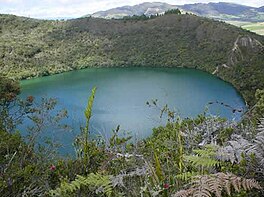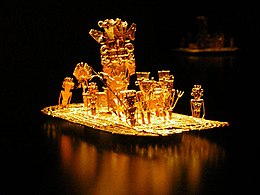
Back بحيره جواتاڤيتا ARZ Laguna Guatavita CEB Guatavita Czech Laguna de Guatavita German Guatavita Esperanto Laguna de Guatavita Spanish Laguna de Guatavita French Lagoa de Guatavita Galician Guatavita (jezero) Croatian Danau Guatavita ID
| Laguna Guatavita | |
|---|---|
 | |
| Location | Sesquilé, Cundinamarca, Colombia |
| Coordinates | 4°58′39.4″N 73°46′30.0″W / 4.977611°N 73.775000°W |
| Max. length | 700 metres (2,300 ft) |
| Max. width | 700 metres (2,300 ft) |
| Surface area | 19.8 ha (49 acres) |
| Max. depth | 125 metres (410 ft) |
| Surface elevation | 3,000 m (9,800 ft) |
| References | [1][2][3] |


Lake Guatavita (Spanish: Laguna Guatavita) is located in the Cordillera Oriental of the Colombian Andes in the municipality of Sesquilé in the Almeidas Province, Cundinamarca department of Colombia, 57 km (35 mi) northeast of Bogotá, the capital of Colombia.
The lake is circular and has a surface area of 19.8 hectares. The earlier theories of the crater's origin being a meteorite impact, volcanic cinder, or limestone sinkhole are now discredited. The most likely explanation is that it resulted from the dissolution of underground salt deposits from an anticline,[3] resulting in a kind of sinkhole.
There are hot springs nearby in the municipality of Sesquilé, which means "hot water" in the now-extinct language of Chibcha, once spoken by the local indigenous people, the Muisca.
Spanish colonizers and Conquistadors knew about the existence of a sacred lake in the Eastern Ranges of the Andes possibly as early as 1531. The lake was associated with indigenous rituals involving gold. However, the first conquistador to arrive at the actual location was Gonzalo Jiménez de Quesada, possibly in June 1537, while on an expedition to the highlands of the Eastern Ranges of the Andes in search of gold. This brought the Spanish into first contact with the Muisca inhabiting the Altiplano Cundiboyacense, including around Lake Guatavita.
The lake is now a focus of ecotourism, and its association with the legend of El Dorado is also a major attraction.
- ^ (in Spanish) Google Maps Area Calculator
- ^ (in Spanish) Google Maps Elevation Finder
- ^ a b Dietz ,R.S.; McHone, J.F. (1972). "Laguna Guatavita: Not Meteoritic, Probably Salt Collapse Crater". Meteoritics. 7 (3): 303. Bibcode:1972Metic...7..303D. doi:10.1111/j.1945-5100.1972.tb00444.x.
- ^ British Museum Collection
© MMXXIII Rich X Search. We shall prevail. All rights reserved. Rich X Search
